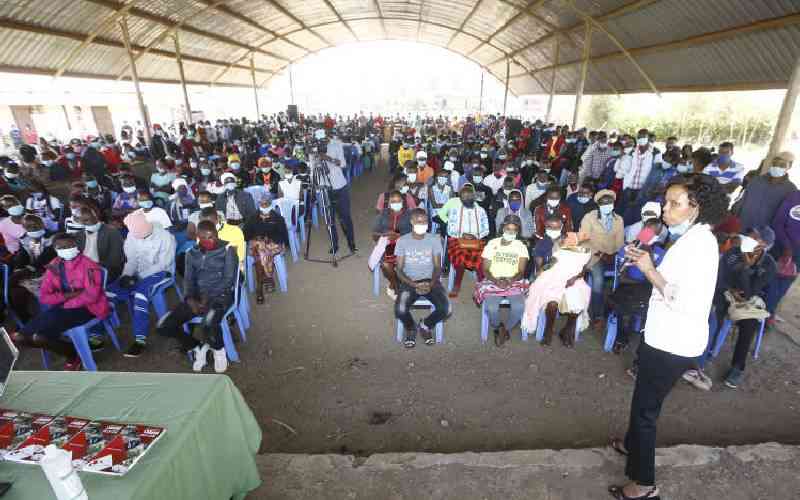
Over 600,000 students who sat the 2023 Kenya Certificate of Secondary Education (KCSE) examinations shunned university and college places despite the availability of places in the institutions.
Data from the Kenya Universities and Colleges Central Placement Service (KUCCPS) shows that out of the 903,137 students who sat the 2023 KCSE exams, some 890,654 were eligible for placement to either university or college.
While announcing the placement results yesterday, KUCCPS Chief Executive Officer Mercy Wahome, however, revealed that only 258,935 students were placed in universities and colleges.
This means that some 604,719 students shunned the available slots for a chance at higher education.
Dr Wahome said the placement body put to consideration on the applicant’s choices, merit, approved capacities and affirmative action for gender, persons with disabilities and marginalised regions to consideration in placing the students to the various institutions.
KUCCPS data shows some 201,146 candidates scored C+(Plus) and above, qualifying for a spot to pursue university degree courses.
However, only 153,274 were placed in degree programmess with Bachelor of Education attracting the highest number of applicants.
Of this, 134,743 will join public universities while 18,558 students will join private varsities in the 2024/25 admission cycle, with male candidates dominating the degree programmes.
KUCCPS says some 11,991 students who scored C+ and above opted to join diploma courses.
Those placed now have until June 5 to seek an inter-university transfer.
On the other hand, the remaining 694,086 attained mean grades of between C and E and were eligible for placement to diploma, craft and artisan programmes in Technical and Vocational Education and Training (TVET) institutions.
Data from the placement agency, however, shows that only 151,192 will be joining the mid-level colleges and TVET institutions.
Dr Wahome revealed that female students were the majority of those placed in TVET, as has been the trend from the 2020/2021 cycle.
She, however, raised concern over the continued posting of low grades in the KCSE examination.
“We are still concerned as the placement body because the lower grades, D+ and below, still account for more than half of the students,” Wahome said.
She spoke during the release of the 2024/2025 universities and colleges placement at the College of Insurance in Nairobi.
Some 63,921 will join TVET institutions under the Ministry of Education. This is despite these institutions having a capacity of 733,063 slots. Thus it will mean that some 669,142 slots in these institutions will remain unutilised.
For TVET institutions outside the management of the Ministry of Education, there were 19,752 slots open for admission but only 3,963 students have been admitted there. This leaves 15,789 slots empty. Teacher Training Colleges offering primary teacher education declared 11,598 spaces for admission but only 9,529 have been filled. This leaves 2,069 vacant admission slots.
For secondary teacher education, the Teacher Training Colleges declared 2,210 slots but only got 734 students. This means 1,476 vacancies remain unfilled.
Kenya Medical Training College(KMTC), however, witnessed a different response as the institutions attracted more admissions than the number of vacancies available. The institutions declared 17,172 slots but ended up getting 19,653 students admitted.
Data from the placement body shows a total of 1,078,806 slots were available for admission to universities and colleges this year.
This means the institutions had a higher capacity than the number of students who sat the 2023 KCSE exams thus all learners could be absorbed to join an institution of higher learning.
To boost the number of admissions, KUCCPS indicated that TVET institutions will progressively admit interested students.
“The institutions will continue admitting walk-in students, which last year accounted for the biggest number of admissions,” said Wahome.
However, the KUCCPS boss said admission to degree programmes was limited to students who sat their KCSE in 2023.
The time frame for students wishing to join KMTC and TVET colleges has been widened. KMTC will consider applicants who sat KCSE in the last 10 years, between 2014 and 2023. On the other hand, TVET considers those who took KCSE from 2000 to 2023.
For TVET students who unsuccessfully applied, Wahome said they will have two more chances to join the institutions in September and January intakes.
Those who sought to join KMTC but failed will also have another chance in the September intake.
“We will allow them to apply afresh at no extra charge,” she said.
A total of 2,452 students in this year’s placement benefited from affirmative action.
University Fund Chief Executive Officer Geoffrey Monari said that the end of the placement will now pave way to the categorisation of students to prepare for funding.
The students will be the second cohort to be admitted under the new funding model that provides varying scholarships and loans to students based on their financial need.
“We are happy that KUCCPS released the placement results early enough and upon the end of the inter-university transfer, the process of funding will begin,” Monari said.